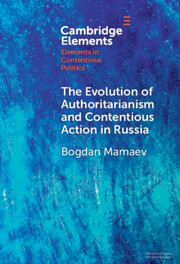Element contents
The Evolution of Authoritarianism and Contentious Action in Russia
Published online by Cambridge University Press: 30 May 2024
Summary
- Type
- Element
- Information
- Series: Elements in Contentious PoliticsOnline ISBN: 9781009560672Publisher: Cambridge University PressPrint publication: 20 June 2024



